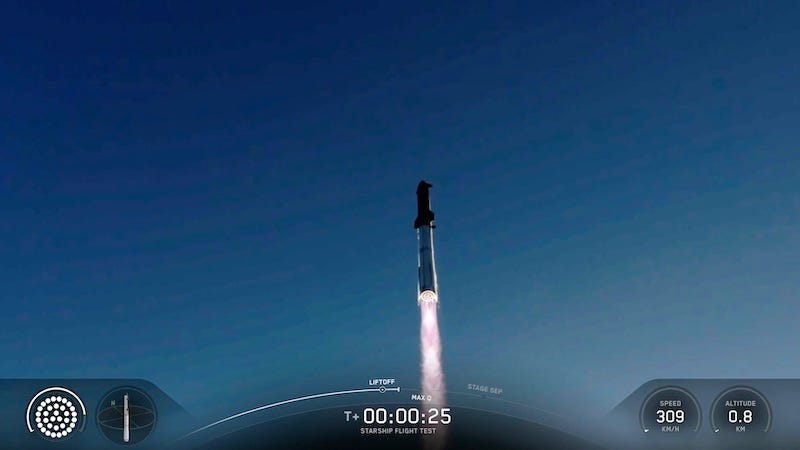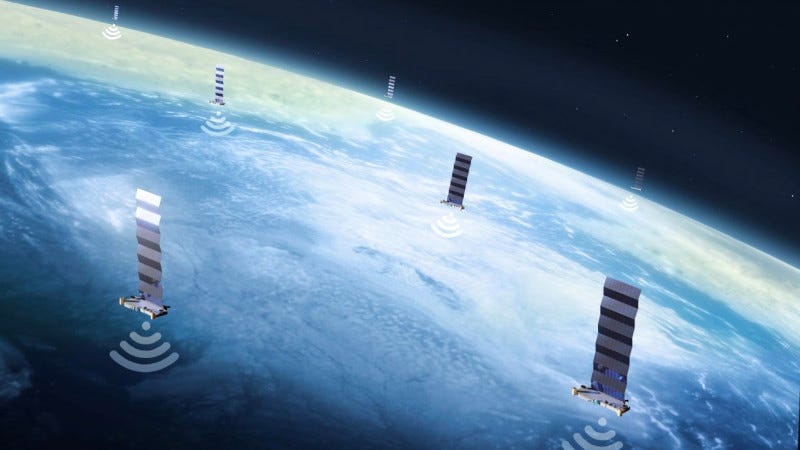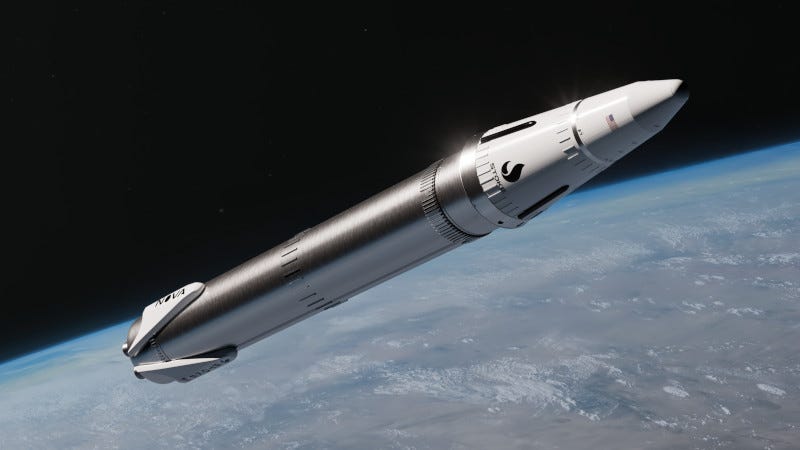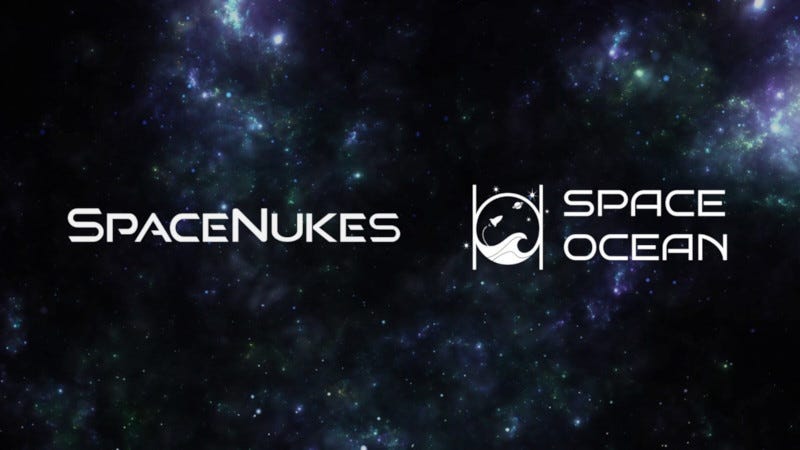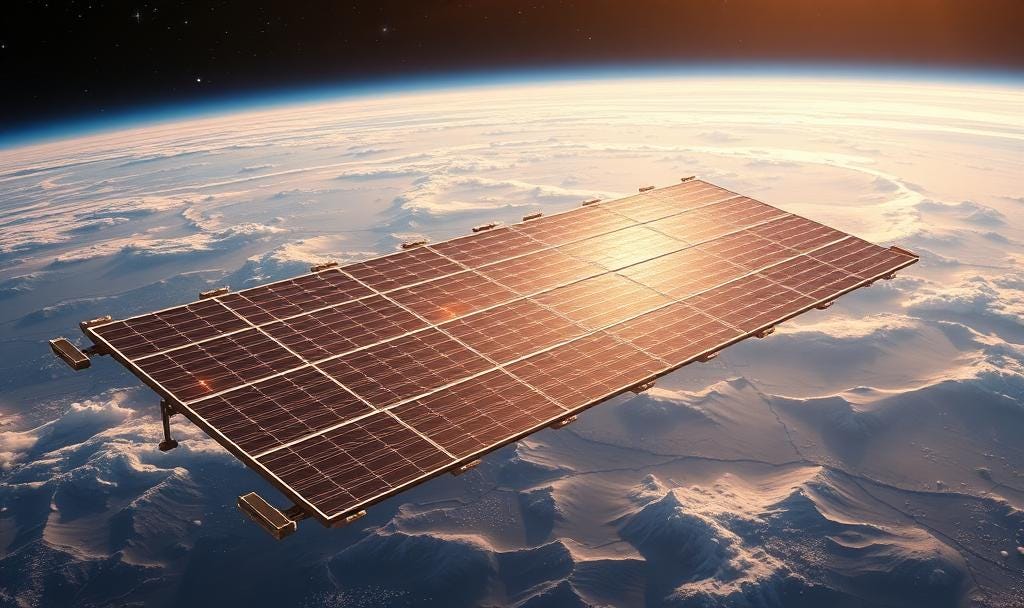The 11th flight test of Starship went off without a hitch Monday, lifting off at 6:23 p.m. CT from Starbase in south Texas and ending with the booster landing in the Gulf of America and Ship splashing down in the Indian Ocean. This was the final flight of the second-generation Starship and first generation Super Heavy booster, as well as the final launch from the current configuration of Pad 1. Every major objective of the flight test was achieved, providing valuable data as SpaceX prepares the next generation of Starship and Super Heavy.
All 33 Raptor engines in the Super Heavy booster operated nominally, and the previously-flown first stage splashed down in the Gulf of America. Ship reached its intended altitude and velocity, deploying multiple Starlink satellite analogs before splashing down in its intended landing zone in the Indian Ocean. In the final minutes of flight, Starship performed a dynamic banking maneuver to mimic the trajectory that future missions returning to Starbase will fly. Starship then guided itself using its four flaps to the pre-planned splashdown zone in the Indian Ocean, successfully executing a landing flip, landing burn, and soft splashdown.
Focus now turns to the next generation of Starship and Super Heavy, with multiple vehicles currently being built and prepared for tests. Dan Hout is a communications specialist for SpaceX. During the live video feed of the test flight, he outlined some of the changes being made in the next iteration of the spacecraft.
“Starting with the Starship upper stage, which is going to look pretty similar on the outside, but it’s getting pretty much a complete overhaul under the hood. We’re getting major design changes to its propulsion system that’s going to accommodate that new version of Raptor, which puts out higher thrust,” Haut said. “We’re also getting energy storage upgrades, tons of avionics changes, a lot of things that will enable longer duration missions. One notable thing you’ll start seeing on the outside are these new docking adapters, which we’ll use when we bring 2 Starships together for propellant transfer. That’s a core capability of Starship that we’re going to demonstrate next year. Bottom line though, this is a Starship we’re planning to use for all of our next major milestones, orbital missions, return to launch site and catch, reuse, propellant transfer, and then making our way to the moon and Mars.”
This next variant will be used for the first Starship orbital flights, operational payload missions, propellant transfer, and more as SpaceX iterates to a fully and rapidly reusable vehicle with service to Earth orbit, the Moon, Mars, and beyond.
-0-
In the 28th edition of ‘Satellites to Be Built and Launched’, Novaspace reveals a decade of record-breaking orbital growth. More than 43,000 satellites are expected to launch by 2035, averaging 12 satellites and 8 tons of payload every day. This surge is set to drive a $665 billion market in manufacturing and launch services, fueled by mega-constellations, defense demand, and rapid innovation in launch technology.
Five mega-constellations will account for 66% of satellites launched between 2025 and 2034 yet contribute just 11% of total market value, according to the report. The rise of such Non-Geostationary Orbit systems and the shift away from legacy GEO models has largely been fueled by Starlink’s demonstration of scalability and flexibility. Budget priorities, meanwhile, sit with defense. Defense remains the market’s economic anchor, capturing 48% of total value despite representing just 9% of satellite volume.
Looking to the launch market, the space transportation sector remains bottlenecked, with SpaceX enjoying a near-monopoly over heavy launches in the West. As several providers strive to introduce or ramp-up competing vehicles, Starship promises to profoundly redefine space transportation and the space economy at large.
Overall, the manufacturing and launch market offers significant revenue potential, however, targeting this opportunity will require a nuanced approach. Only 7% of the manufacturing market in value is fully open to any manufacturer and 70% is considered “nationally captive”, with the remainder locked by vertical integration of constellations.
-0-
Stoke Space recently announced that it has raised $510 million in a Series D funding round. The round was led by Thomas Tull’s US Innovative Technology Fund (USIT) in conjunction with a $100 million debt facility led by Silicon Valley Bank. Stoke’s new financing, which more than doubles its total capital raised to $990 million, will accelerate product development and expansion.
Earlier this year, the U.S. Space Force awarded Stoke a National Security Space Launch contract that will expand the country’s access to space. The award reflects the growing demand for medium-lift capacity across commercial, defense, and emerging architectures, such as the Golden Dome. Stoke’s fully and rapidly reusable Nova launch vehicle is being developed to provide high-frequency access to orbit and support missions to, through, and from space, including satellite constellation deployment, in-space mobility, and downmass.
The new capital will expand production capacity for the Nova vehicle and complete activation of Launch Complex 14 at Cape Canaveral.
-0-
Coming up, tracking orbital objects for fun and profit. But right now, why not take a minute to become a paid subscriber to The Journal of Space Commerce. Whether you’re a space professional, investor or an enthusiast, paid subscribers have first access to premium articles and podcasts focused on the new space economy. Just visit www.exterrajsc.com on Substack, and help keep The Journal of Space Commerce independent as we chronicle, cajole and, when necessary, critique the commercial space industry.
This week on The Journal of Space Commerce podcast, Tom Patton talked with Araz Feyzi, company co-founder and Chief Technical Officer, and Hyun Seo, Chief Product Officer at Kayhan Space.
No one knows precisely how many objects there are in Earth orbit. Estimates range from NASA’s 31,000 to just over 40,000, according to ESA. But at some point, it just becomes a large number. The bottom line is there are a lot of satellites, defunct spacecraft, parts of spacecraft and outright junk orbiting the Earth, and any one of them could cause a catastrophe.
Kayhan Space is working to catalog and track both functioning satellites and orbital debris. Their SatCat program allows governments, businesses and the general public to see and follow what is out beyond the atmosphere. SatCat is a follow-on product to Pathfinder, their cloud-based collision avoidance service that automates conjunction assessment and maneuver planning.
Feyzi explained that SatCat draws data from multiple sources to present a wealth of information to its users.
“SatCat is kind of a data aggregation platform and automation platform. We ingest data from various data sources, from (the) US Space Force’s catalog to almost close to 10,000 ephemerides from satellites that have GPS on board, to commercial data that we procure and purchase from commercial data providers. And all of that gets combined together and kind of creates this most comprehensive space object catalog,” Feyzi said. “Why I say most comprehensive is because when you have maneuver plans and very precise trajectories from almost 10,000 satellites on a platform, you don’t get that kind of up-to-date and live data from space objects ever.”
The company was recently selected for the Office of Space Commerce’s TraCSS data quality monitoring service, and recently launched a GPU-accelerated SGP4 propagator purpose-built for large-scale satellite modeling.
-0-
The advancement of space nuclear power systems is the subject of a Letter of Intent (LoI) recently signed between Space Ocean Corporation and Space Nuclear Power Corporation (Space Nukes).
The LOI outlines a strategic collaboration to explore integrating space nuclear reactor technology into future deep-space missions.
Under the terms of the LOI, Space Ocean intends to test Space Nukes’ 10-kilowatt nuclear reactor aboard its ALV-N satellite. If performance criteria are met, Space Nukes will become a core supplier of nuclear power units for future Space Ocean missions focused on lunar and planetary operations.
While non-binding, the LOI represents a meaningful alignment between two companies working to solve critical challenges in long-range mission design, logistics and autonomy.
-0-
Which leads us to our In Depth section this week. Nuclear power in space is one thing, but another long-sought-after technology is the ability to beam solar energy from satellites to Earth. But is that technology ready for prime time?
A controversial 2024 NASA study ignited fierce debate within the SBSP community, particularly drawing sharp criticism from John Mankins, the aerospace engineer who led NASA’s landmark “Fresh Look” study in the late 1990s. With China, Europe, and Japan accelerating their own SBSP programs, and private companies claiming economic viability is within reach, the global race to commercialize orbital solar power stations has entered a critical phase that will determine whether SBSP can genuinely compete with terrestrial energy alternatives.
The economics of SBSP fundamentally depend on launch costs, which have undergone dramatic transformation in recent years. SpaceX currently charges approximately $2,700 per kilogram for Falcon 9 launches, while Falcon Heavy delivers payloads at roughly $1,400 per kilogram to low Earth orbit. The game-changing variable is Starship, SpaceX’s fully reusable super-heavy lift vehicle that company executives project could reduce launch costs to as little as $100 to $200 per kilogram once operational at scale. John Bucknell, a former SpaceX rocket engineer who founded Virtus Solis, asserts that once launch costs fall below $200 per kilogram, space-based solar power becomes cheaper than Earth-based nuclear plants and fossil fuel power stations.
But the cost per kilowatt-hour for consumers still varies greatly. A 2024 survey conducted by Virtus Solis analyzing seven competing SBSP architectures concluded that their design could achieve a levelized cost of energy of $25 per megawatt-hour. But a European study projects SBSP costs between €88.5 and €155.5 per megawatt-hour in 2040, or about $102 to $180 at today’s exchange rates.
The California Institute of Technology (Caltech) successfully operated the Space Solar Power Demonstrator (SSPD-1) from January 2023 through late 2023, testing three essential technologies: wireless power transmission in space, performance comparison of 32 different solar cell types in the space environment, and lightweight deployable structures. The results were promising, but Caltech President Thomas Rosenbaum concluded that “solar power beamed from space at commercial rates, lighting the globe, is still a future prospect.” A NASA study compared Space-Based Solar Power against multiple terrestrial alternatives, concluding that under baseline assumptions, terrestrial options maintain overwhelming cost advantages, but acknowledged that technology improvements across launch, manufacturing, and system efficiency could shift the calculus.
For now, critical research gaps remain before SBSP transitions from demonstration to deployment. Issues that remain to be resolved include the ability to wirelessly transmit power efficiently over thousands of kilometers, thermal management of high-power systems, and long-duration component reliability in the space radiation environment exceeding the operational heritage of current satellite systems.
So is Space-Based Solar Power ready for prime time? It would appear that at least for now it will remain in the realm of science fiction.
Paid subscribers can read the full analysis on The Journal of Space Commerce under the ‘In Depth’ tab. While you’re there, check out our article exploring the issues with space governance.
And those are some of the top stories we covered for you on The Journal of Space Commerce this week. Space Commerce Week is a production of Ex Terra Media. You can get daily updates on space commerce by subscribing to The Journal of Space Commerce on Substack at www.exterrajsc.com. And please consider becoming a paid subscriber. Whether you’re a space professional, investor or an enthusiast, paid subscribers have first access to premium articles and podcasts focused on the new space economy. Just visit www.exterrajsc.com and help keep The Journal of Space Commerce independent as we chronicle, cajole and, when necessary, critique the commercial space industry.
-0-
Worth a Second Look
Agriculture, Defense, and Energy Drive Satellite Data Services Market
Partnership Reaffirmed Between Varda Space, Southern Launch
Two Multi-Launch Agreements Inked by Rocket Lab
Definitive Commercial Agreement Reached by Verizon, AST SpaceMobile




